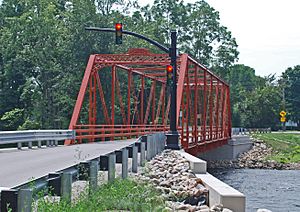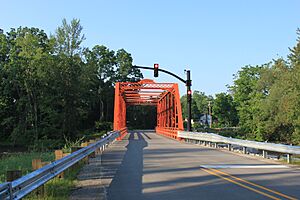Delhi Bridge facts for kids
Quick facts for kids Delhi Bridge |
|
|---|---|
 |
|
| Coordinates | 42°20′01″N 83°48′33″W / 42.3337°N 83.8091°W |
| Characteristics | |
| Number of spans | 1 |
|
Delhi Bridge
|
|
| Built | 1888–1890 |
| NRHP reference No. | 08000844 |
| Added to NRHP | September 4, 2008 |
The Delhi Bridge, also known as the East Delhi Bridge, is a special one-lane bridge in Washtenaw County, Michigan. It carries East Delhi Road over the Huron River. This bridge is made of wrought iron and uses a design called a Pratt through truss. This means the main support structure is above the road.
The bridge was finished on October 12, 1883. It replaced an older wooden bridge from 1851. In 1917, a big tornado badly damaged the bridge. But it was rebuilt and put back together. In 2005, the bridge was closed because it was unsafe. After a big renovation, it reopened in 2009. The Delhi Bridge is now listed on the National Register of Historic Places. This means it's an important historical site.
Contents
History of the Delhi Bridge
How the Bridge Was Built
The Delhi Bridge was built by a company called the Wrought Iron Bridge Company from Canton, Ohio. Its construction was completed on October 12, 1883. It took the place of an older wooden bridge that had been there since 1851.
The steel parts for the bridge were made by the Trenton Iron Company. The bridge was put together using pins instead of rivets. This pin technology was not used much after 1910. The bridge was built in a place called Delhi Mills. This was a mill town that became much smaller in the early 1900s.
The Tornado and Rebuilding
On June 6, 1917, a powerful tornado hit the town. It caused a lot of damage to the bridge. The tornado lifted the bridge off its supports and left it twisted in the river. Luckily, the supports were not damaged.
Local stories say that Edward Outwater and Eli Gallup used horses to pull the bridge out of the river. The bridge was rebuilt in 1918. Many of its original parts were reused. This is clear because some parts still show damage from the tornado. The sign at the entrance of the bridge was also reused. During the rebuilding, the bridge's supports were also fixed.
Before its recent renovation, the northern support was covered with concrete. The southern support was made of fieldstone and was likely original. The Delhi Metropark, which opened in the 1950s, has made the bridge a popular place to visit.
Saving the Bridge: 2005 to Today
After the tornado, the bridge was mostly just maintained. In June 2005, a yearly check showed that the bridge was in very bad shape. Because of this, the Washtenaw County Road Commission closed the bridge to cars.
In 2006, the road commission thought about replacing the bridge. They considered building a new two-lane concrete bridge. But local people wanted to save the old, historic bridge. They convinced the road commission not to replace it.
A group called the East Delhi Bridge Conservancy was formed to help save the bridge. They did research and found out that the bridge was indeed the same one that had been there before the tornado. This meant the project could get special funding. The Delhi Bridge was the first one-lane bridge in Michigan to get these funds for repairs.
Repairs started in July 2008. New guardrails and traffic lights were put in. In August 2008, large cranes lifted the bridge off its supports. It was placed on the side of the river. The bridge was fixed, painted, and both supports were replaced. The bridge used to be a dark, rusty red color. The new color was meant to be similar, but it turned out to be an industrial orange. This surprised some people in the conservancy.
In July 2009, the bridge was lifted back onto its supports. About fifty people came to watch this event. The bridge was reopened to cars in August 2009. A special ceremony was held on September 13, 2009. Instead of a ribbon, yellow caution tape was used. State Representative Pam Byrnes spoke at the event. The repairs cost about $1.2 million. Most of this money came from the special funding program. A twenty-year tax was put in place to pay for future maintenance.
In July 2011, someone spray-painted graffiti on the bridge.
Why the Bridge is Historic
In 2005, the Michigan State Historic Preservation Office decided that the bridge was important enough to be on the National Register of Historic Places. This is because of its design and how it was built. It is one of the few wrought iron Pratt through truss bridges left in Michigan from the late 1800s.
It is also one of only five bridges built by the Wrought Iron Bridge Company in Michigan that still exist. Only two of these are still in their original locations. In June 2007, Washtenaw County made the area around the bridge a local historic district. On September 4, 2008, the bridge was officially added to the National Register of Historic Places.
Bridge Design
The Delhi Bridge carries the northern part of East Delhi Road over the Huron River. It is a single-span, one-lane bridge. It has a Pratt through truss design and is made of wrought iron. Since it's a one-lane bridge, there are traffic lights at each end. These lights help control cars crossing the bridge safely.




